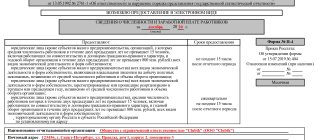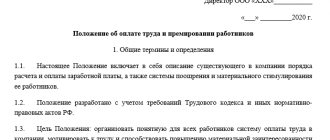The SSSC for 2021 must be submitted by January 21! Our article will help with this. We tell you in detail how to make the calculation (with an example). You can download our form and fill it out (free of charge and without registration) or take advantage of the free test drive of Kontur.Externa and submit it electronically!
Employers must report to the tax authorities every year how many people work in their company. This is necessary so that the Federal Tax Service can determine in what form you should submit reports and whether you qualify for the restrictions of a small business or a special tax regime. This is one of the simplest reports, because it has only one main indicator and one sheet in the form. But even here, difficulties may arise, especially in terms of calculating the average number of employees. In this article we will tell you where and when to submit the report, how to fill out the form and calculate the main indicator.
Who should report for 2021
Organizations and individual entrepreneurs are required to submit to the Federal Tax Service at the end of each year information on the average number of employees for the past year. However, individual entrepreneurs who did not hire employees last year do not have to submit such reports (paragraph 6, paragraph 3, article 80 of the Tax Code of the Russian Federation).
Thus, the following are required to submit a report to the tax office on information about the average headcount in 2021:
- all organizations, regardless of whether they have employees;
- Individual entrepreneurs who hired at least one employee under an employment contract in 2021.
Penalty for failure to submit information about the average number of employees
Tax legislation establishes administrative liability if the KND form 1110018 was sent in violation of the established deadlines, or was not submitted at all.
A business entity faces a fine of 200 rubles for failure to timely submit a report to the Federal Tax Service.
There is also a punishment for the responsible person in the organization for drawing up and submitting the report, who violated the deadline for sending the report. For him, the fine can vary from 300 to 500 rubles.
At the same time, it is necessary to take into account that the application of penalties to violators does not relieve the company of the obligation to send a report on the average number to the tax office.
Attention! The norms of the Tax Code of the Russian Federation provide for repeated failure to submit this report to punish both the company and its responsible persons with double fines.
Report due date 2021
The deadline for submitting information for 2021 is 01/21/2019.
Thus, after returning to work in January 2021, accountants will have 8 working days to fill out and submit reports on the average headcount for 2021. Moreover, this information can be submitted directly on January 21, 2021 - this will not be considered a violation (paragraph 6, paragraph 3, article 80 of the Tax Code of the Russian Federation).
What is what: definitions
Let us define the differences in terms of “appearance number of employees” and “average number of employees.”
The number of employees present is the number of employees who actually came to the workplace. This category does not include persons who are absent due to vacation, illness, business trip, etc.
Persons with whom the employer has an employment contract are those categories of employees who are included in the average number of employees.
The average number of employees is those who work for one day or more in temporary, permanent or seasonal work. This group should include both persons who actually worked a working day and those who were absent for some reason:
- those who actually visited the workplace (including those who did not work due to downtime);
- were on business trips;
- absent due to illness.
An employee who works in an institution for more than one position (less than one position) or belongs to the category “internal part-time worker” is included in the calculation as one whole unit.
This category does not include:
- persons who work under a GPC agreement;
- external part-time workers;
- students in educational institutions in the areas of enterprises.
Thus, the payroll number actually coincides with the number of employees recorded according to the working time sheet.
Which employees should be included in the headcount?
Recommendations for filling out information on the average number of employees are in the letter of the Federal Tax Service dated April 26, 2007 No. CHD-6-25/353. The categories of employees that need to be taken into account in the calculation are presented in the table. Do not count employees who are not on the list.
| Employee category | How is the number taken into account? | |
| Regular full-time employees (including probationary employees) | The number of such employees is fully taken into account | |
| Employees hired to replace absent employees (for example, a woman on maternity leave) | The number of such employees is fully taken into account | |
| Employees with fixed-term employment contracts | The number of such employees is fully taken into account | |
| Internal part-timers | Counted as one unit when calculating | |
| External part-timers | When calculating the average headcount, this indicator is not taken into account | The average number of such employees is determined in terms of full-time employment (by dividing the person-days worked by the number of working days according to the calendar in the reporting month) |
| Employees on sick leave | The number of such employees is taken into account in full (regardless of the actual time worked) | |
| Employees on leave (annual or additional) | The number of such employees is taken into account in full (regardless of the actual time worked) | |
| Employees who are on leave without pay (regardless of the length of leave) | The number of such employees is taken into account in full (regardless of the actual time worked) | |
| Employees who are: – on maternity leave; – on leave in connection with the adoption of a newborn child; – on maternity leave | Do not take into account the number of such employees when calculating. Exception: employees who are on parental leave if they work part-time or from home while maintaining the right to receive benefits | |
| Seconded employees, if they maintain average earnings (including for short-term business trips abroad) | The number of such employees is fully taken into account | |
| Homeworkers | The number of such employees is fully taken into account | |
| Employees who are required by law to have reduced working hours (minors, disabled people of groups I and II, employees of hazardous industries, etc.) | The number of such employees is fully taken into account | |
| Employees who are employed part-time or part-time (in accordance with the employment contract or with their consent) | When calculating the average headcount, such employees are taken into account in proportion to the time worked | The average number of such employees is determined in terms of full-time employment (by dividing the person-days worked by the number of working days according to the calendar in the reporting month) |
| Employees transferred to part-time work at the initiative of the administration (without written consent) | The number of such employees is fully taken into account | |
| Employees temporarily sent from other organizations (if they do not retain the average salary at their main place of work) | The number of such employees is fully taken into account | |
| Full-time employees with whom civil law contracts have additionally been concluded | When calculating the average headcount, such employees are taken into account once | When calculating the average number, such employees are not taken into account |
| Freelance employees with whom contracts and other civil contracts have been concluded | When calculating the average headcount, such employees are not taken into account | When calculating the average number, such employees are taken into account for each calendar day as whole units throughout the entire period of the contract, regardless of the period of payment of remuneration |
| Entrepreneurs with whom contracts for construction, paid services and other civil law contracts have been concluded | Do not take into account the number of such employees when calculating | |
| Employees who combine work and study and are on study leave while maintaining their average earnings | The number of such employees is fully taken into account | |
| Employees who combine work with training and are on vacation at their own expense | Do not take into account the number of such employees when calculating | |
| Employees who have been granted leave at their own expense in connection with passing entrance exams to a university, college, etc. | Do not take into account the number of such employees when calculating | |
| Employees sent for training (upgrading their qualifications, acquiring a new profession) outside of work (if they maintain average earnings) | The number of such employees is fully taken into account | |
| Citizens (military personnel and persons serving sentences of imprisonment) recruited for work under special contracts with government organizations for the provision of labor and included in the average number of employees | When calculating the average number of employees, such employees are taken into account as whole units based on the days they report to work. | When calculating the average number, such employees are not taken into account |
| Employees transferred to work in another organization if their salary is not maintained, as well as those sent to work abroad | Do not take into account the number of such employees when calculating | |
| Citizens with whom a student agreement for vocational training has been concluded (with a scholarship) | Do not take into account the number of such employees when calculating | |
| Employees who submitted a letter of resignation and stopped working before the expiration of the notice period or stopped working without warning the administration | When calculating, do not take into account the number of such employees from the first day of absence from work. | |
| Owners of an organization who do not receive a salary | Do not take into account the number of such employees when calculating | |
| Members of the cooperative who have not concluded employment contracts with the organization | Do not take into account the number of such employees when calculating | |
| Lawyers | Do not take into account the number of such employees when calculating | |
| Military personnel in the performance of military service duties | Do not take into account the number of such employees when calculating | |
| Owners of an organization receiving a salary | The number of such employees is fully taken into account | |
| Full-time employees who actually showed up for work (including those who did not work due to downtime) | The number of such employees is fully taken into account | |
| Employees who did not show up for work due to the performance of state or public duties | The number of such employees is fully taken into account | |
| Employees with special titles | The number of such employees is fully taken into account | |
| Students and students of educational institutions working in organizations during practical training, if they are enrolled in jobs (positions) | The number of such employees is fully taken into account | |
| Employees who were: – idle (both at the initiative of the employer and for reasons beyond the control of him and the employee); – on unpaid leaves at the initiative of the employer | The number of such employees is fully taken into account | |
| Employees who took part in strikes | The number of such employees is fully taken into account | |
| Employees working on a rotational basis | The number of such employees is fully taken into account | |
| Employees under investigation pending a court decision | The number of such employees is fully taken into account | |
| Employees temporarily absent from work due to the fact that the administration granted them time off for overtime | The number of such employees is fully taken into account | |
| Employees temporarily absent from work due to absenteeism | The number of such employees is fully taken into account | |
What other indicators characterize the number of employees of an organization?
According to Rosstat Order No. 772, the aggregated indicator of the number of employees of an enterprise is the average number of personnel. It is determined by summing the number:
- average;
- average number of external part-time workers;
- the average number of individuals who performed work under civil contracts.
Often, to analyze labor resources, calculations are used based on data about employees who actually went to work. The number of employees present is the number of employees on the payroll who went to work. Analysis of this indicator allows us to assess the efficiency of using labor resources and identify lost working time. If the number of staff present is much less than the average, this is a reason to think about the quality of staff work.
Sample of filling out a report in 2021 (number for 2021)
Now, using an example, we will show a specific example of filling out information on the average number of employees for 2021, which must be submitted no later than January 21, 2021. In your report, show:
- TIN and checkpoint;
- company name or full name individual entrepreneur;
- average number of employees (persons);
- data as of January 01, 2021;
- data of the manager or representative;
- date and signature.
A sample of filling out the main part of the form for information on the average number of employees for 2021 will look like this:
How to calculate
Calculate the average headcount (ASH) for 2021 according to the Instructions approved by Rosstat Order No. 772 dated November 22, 2017.
Prepare and submit information on the average number of employees via Kontur.Extern.
Send a request
Step 1
To calculate the average headcount for the year, you must first find this indicator for each month. To do this, count all the employees who were registered with the company on each day of the month. Do not forget:
- include employees on vacation, sick leave, business trips, etc.;
- equate the total number of employees on holidays and weekends to the number of employees on the previous working day.
An example of calculating the monthly average
IP Lavrov employed 11 people in November. Eight of them worked for a full month. Two people got hired on November 13, and another employee came on the 25th. Total:
- from November 1 to November 12 - 8 people;
- from November 13 to 24 - 10 people;
- from November 25 to 30 - 11 people.
Let's calculate: ((12 days × 8 people) + (12 days × 10 people) + (6 days × 11 people)): 30 = (96 + 120 + 66): 30 = 282: 30 = 9.4 .
Step 2
Now we need to take a closer look at employees who work part-time. According to the Guidelines, in this case, employees must be counted in proportion to their working time.
Example of accounting for part-time employees
Individual entrepreneur Lavrov has a five-day work week, 8 working hours a day.
In November, he hired two employees who worked three days a week for 5 hours and worked a total of 130 hours. Let's calculate the average time: 130 hours / (8 hours × 21 days) = 0.77 people.
Thus, the average number of individual entrepreneurs in November, taking into account rounding, will be: 9.4 + 0.77 = 11 people.
Step 3
When we have calculated the average value for all previous months, we can begin to calculate the indicator for the year. To do this, you need to add up the number of all months and divide by 12.
An example of calculating the average value for a year
Over the course of the year, the number of employees at Vensky LLC changed as follows:
| Month | Number of people, people |
| January | 138 |
| February | 146 |
| March | 143 |
| April | 152 |
| May | 149 |
| June | 133 |
| July | 128 |
| August | 144 |
| September | 156 |
| October | 162 |
| november | 173 |
| December | 176 |
The TSS for 2021 will be: (138 + 146 + 143 + 152 + 149 + 133 + 128 + 144 + 156 + 162 + 173 + 176): 12 = 149.75 people.
The resulting figure must be rounded to whole numbers and entered into the information about the average headcount for 2021. Therefore, the report should include 150 people.
Calculation of the SCH in a newly created organization
The procedure for calculating the SCH for new organizations is slightly different. In this case, you need to multiply the number of personnel by the number of days of work in a month (including weekends) by the total number of days in a month.
An example of calculating the average cost for a new organization
IP Lavrov began working only on October 14, 2021.
8 employees were hired under an employment contract, and their number did not change throughout October. Let's calculate the total cost: 18 days * 8 people = 144. Although the organization worked for only 18 days, the resulting amount must be divided by the number of calendar days in October - 31. We get 144: 31 = 4.64, rounded to 5 people.
Methods for submitting a report in 2019
Information on the number of employees – special reporting. There are no mandatory requirements for the method of submitting such information. In 2019, you can submit them to the tax office:
- or on paper (through a representative, by mail);
- or in electronic form via telecommunication channels.
This follows from paragraph 3 of Article 80 of the Tax Code. The electronic format of information on the number was approved by order of the Federal Tax Service dated July 10, 2007 No. MM-3-13/421.
Read also
21.08.2018
Why do regulatory authorities need information about the number of employees of an organization?
Government agencies use information about the number of employees at an enterprise for various purposes. Based on such data, Rosstat analyzes employment by industry and locality.
The average number of employees in 4-FSS 2021 is used to control the form of reporting and the correctness of the calculations made. So, in order to have the right to provide a report on paper, the average number of employees in 4-FSS 2018 should not exceed 25 people. If the indicator is higher, then the report can only be submitted electronically.
The Federal Tax Service also needs data to control the reporting form, as well as to track the right to use special regimes and preferential conditions for accounting. For example, a micro-enterprise whose number of employees in 2021 did not exceed 15 people does not apply PBU 18/02, writes off any inventories immediately as expenses, presents simplified accounting statements and is exempt from statistical reporting.
We count the payroll for the month
In order to calculate the SCN for a month, you should sum up the SCN of full-time and part-time employees (working part-time by agreement). Persons who are required by law to work part-time must be counted as fully employed.
The SCN of persons who are fully employed is calculated in accordance with their payroll number in each calendar day of the month: from April 1 to April 21 - 50 people, from April 22 to April 30 - 51 people. The TRP for April will be 50.3 ((50 people × 21 days + 51 people × 9 days) / 30 days). By rounding we get 50 people.
The list number of employees taken into account on weekends and holidays is identical to the number for the previous day of work: an employee dismissed on Friday must be included in the figure for weekends (Saturday and Sunday).
Part-time accounting
To ensure the calculation of the average number of part-time employees, it is necessary to determine how many hours such employees worked in the reporting month. Salary is not required to calculate the average headcount. If an employee is on vacation or sick leave, the number of hours per day must be calculated based on the last working day.
The second step is to count the number of employees of the institution. To do this, the sum of hours is divided by the volume of working hours (the product of the number of working days and the number of hours of work per day). For example, an employee worked 14 days, 6 hours each, in March. The desired value will be calculated using the formula:
(14 days × 6 hours) / (20 calendar working days × 8 hours) = 84 / 160 = 0.53.







